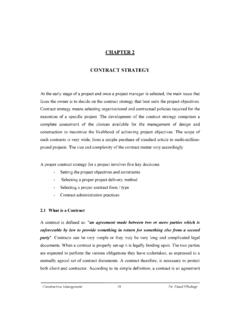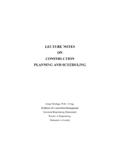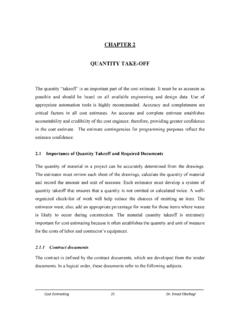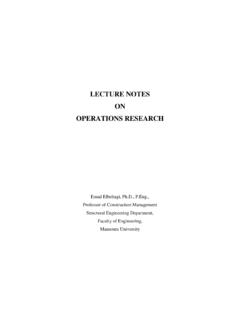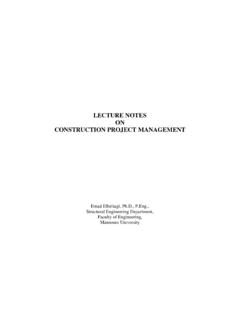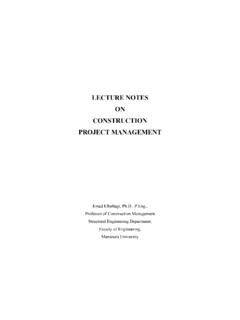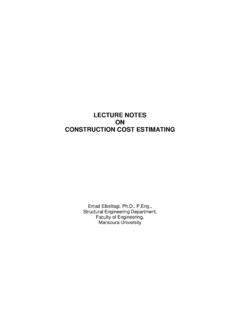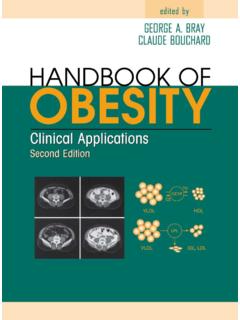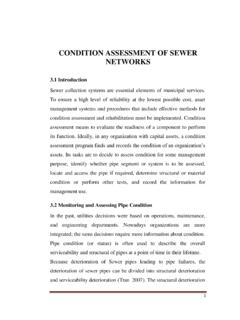Transcription of CHAPTER 4 COST OF CONSTRUCTION LABOR AND …
1 CHAPTER 4. cost OF CONSTRUCTION LABOR AND EQUIPMENT. CONSTRUCTION labors influence every part of a project. They operate equipment and fabricate and install materials. Detailed estimate requires the breakdown of project costs into the LABOR , material and equipment costs. Thus type of estimate need to have a design available to get such required details. This CHAPTER introduces the details of estimating LABOR , equipment and material costs as the basis for detailed cost estimate of CONSTRUCTION projects.
2 Preparing the Detailed Estimate If a contractor chooses a project he or she can professionally and financially handle, it is worthwhile to expend all efforts to win the bid. In addition, the contractor must successfully pass a qualification screening. After the decision to bid, arrangements need to be made to pick up the contract document and prepare a detailed cost estimate. The steps listed below, in logical order, are the road map for developing a detailed estimate. One: Review the bidding documents.
3 Check for general conditions, specifications and all the drawings. If any discrepancies exist, record them and check with the architect or engineer. The general conditions and specifications are generally organized into the following sections: the bid, the owner/contractor agreement, bonds, alternates, general conditions, specifications, and addenda. The bid section includes the invitation to bid, instructions to bidders, and bid forms. The invitation to bid contains a description of the nature, extent, and location of the project as well as contact information for the owner.
4 The documents should also cost Estimating 64 Dr. Emad elbeltagi contain date, time and place that bids will be received; general contractor and subcontractors' prequalification requirements; date, time, and location of any pre- bid conference; availability of bidding documents with their dates, locations, and procurement costs; and bond requirements. The owner/contractor agreement section is most often a standard document that formalizes the CONSTRUCTION contract price and CONSTRUCTION duration. It should also list progress payments retained, percentage of completed work value, acceptance conditions, and final payment constraints.
5 The bond section should include bid bond and performance bond forms and requirements. Bonds are written documents that describe the conditions and obligations related to the owner/contractor agreement. A bid bond certifies that if a contractor is awarded the bid within the time specified in the invitation to bid, the contractor will enter into the contract and will provide all other required bonds in a timely manner. A performance bond guarantees the owner that within agreement limits the contractor will perform all work in accordance with the contracting document.
6 LABOR and material bonds guarantee to the owner that the contractor will pay in a timely fashion for supplied materials used by all the subcontractors related to the project. Two: Review the drawings to visualize the building size, height, shape, function, basements, and so on. Start with floor plans, cross-sections, exterior finish system, and the roof. Note all unusual CONSTRUCTION procedures, building systems, and materials that have been specified. Three: Review structural drawings to get acquainted with specified systems: reinforced concrete, structural steel, masonry, wood, or combinations.
7 Find out which pieces of heavy CONSTRUCTION equipment will be needed for erection and for how long. Pay attention to various wall sections, materials and prefabricated assemblies. Four: Review mechanical, electrical, fire extinguisher, and security drawings. Record any possible interference with substructure and superstructure erection. cost Estimating 65 Dr. Emad elbeltagi Five: Start identifying work to be done by general contractor and work to be done by subcontractors. Six: Read and study thoroughly the specifications for the work to be done by the general contractor and those related to any subcontracted work.
8 Also, review general conditions and note the items that will affect project costs. Seven: Visit the project site and have with you the project manager or field engineer. Eight: Call a meeting with the personnel who will hold the key supervisory positions. Establish with them the general guidelines for quantities take off and pricing. Nine: Develop a list of subcontractors. Notify subcontractors and suppliers that the company is preparing a proposal and ask if they intend to submit bids. Ten: Following the site visit and staff consultation, develop a list of items to be considered for jobsite overhead and general overhead that need to be priced later.
9 Eleven: Start the quantities takeoff for the category of CONSTRUCTION work selected to be done in house (most often site work, foundations, and concrete work). When taking off quantities, break each item down by size, type of material, and workmanship. Also list the type of CONSTRUCTION equipment needed for each phase. Twelve: Condense quantities from the work up sheet by work category and transfer them to a summary sheet for pricing. Pricing means the cost of materials, LABOR , and CONSTRUCTION equipment.
10 The prices used are from company available cost files adjusted to a particular location, or from quotes from suppliers and subcontractors. Sources of cost Information Not all cost information has the same reputation for accuracy and reliability and care should be exercised when choosing cost data for a new estimate. cost information required for pricing different work items may be gathered or compiled from different sources. - cost information from published price books such as US Means. Price books are published annually and contain a range of prices for standard bills of quantities items.
